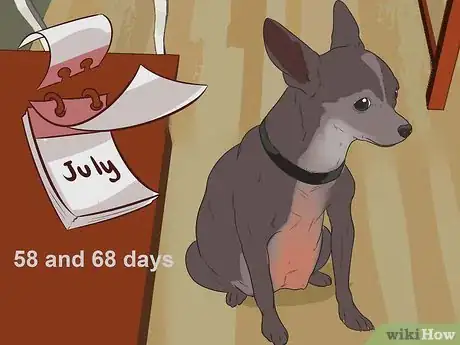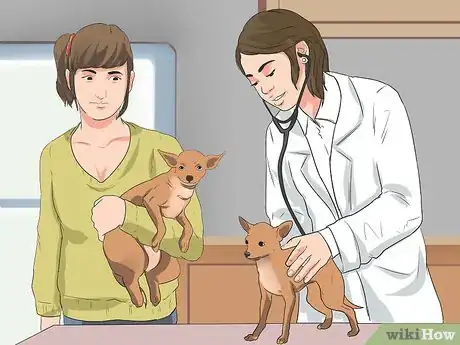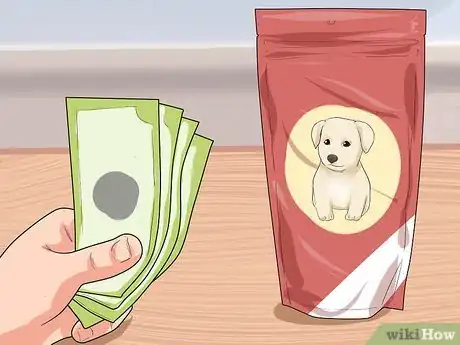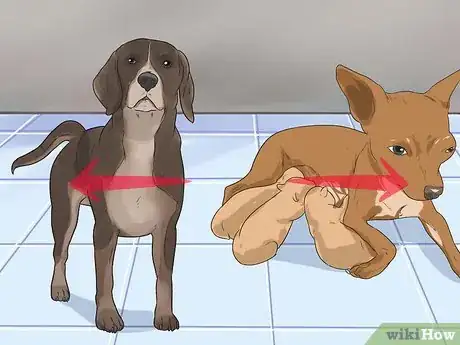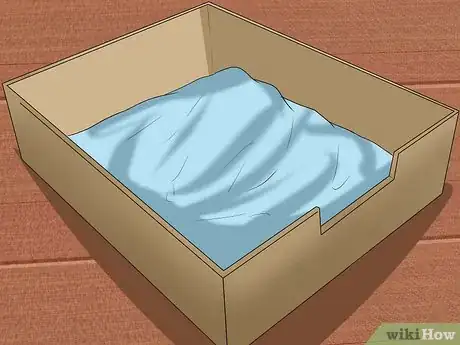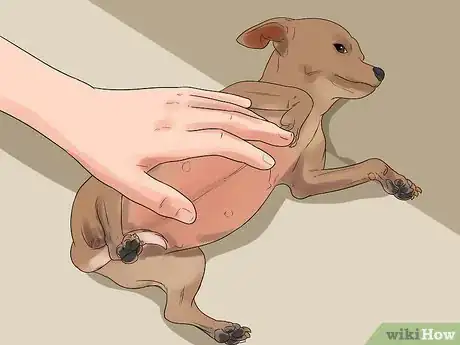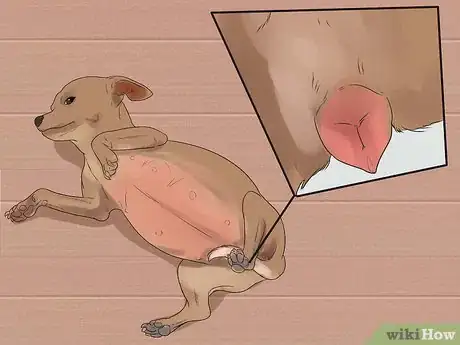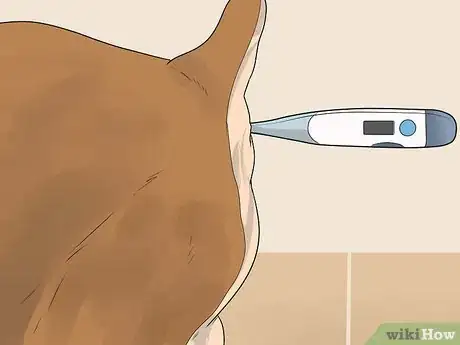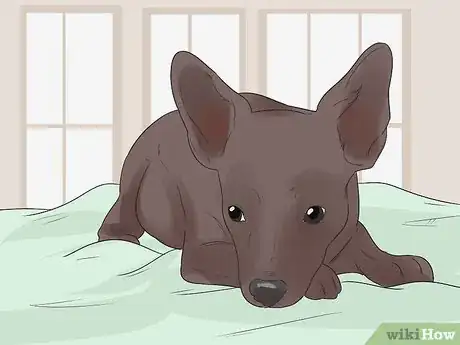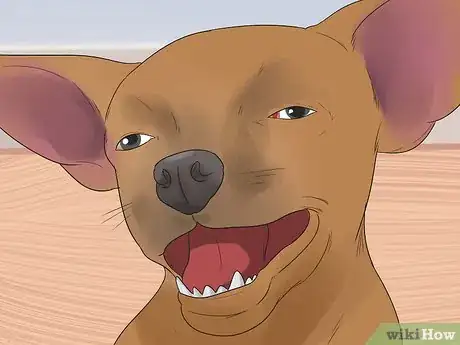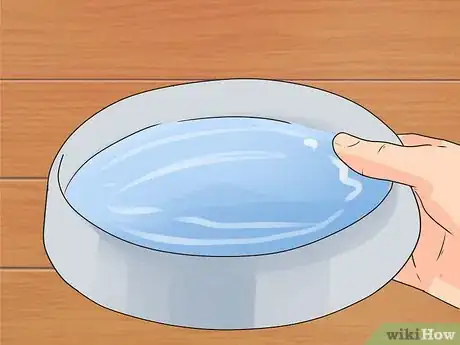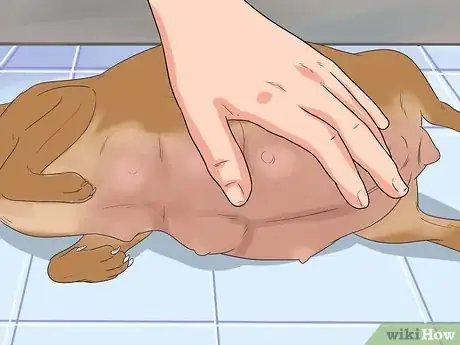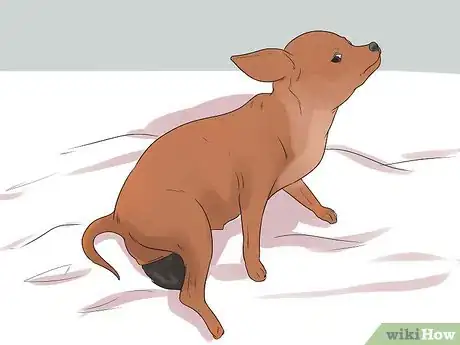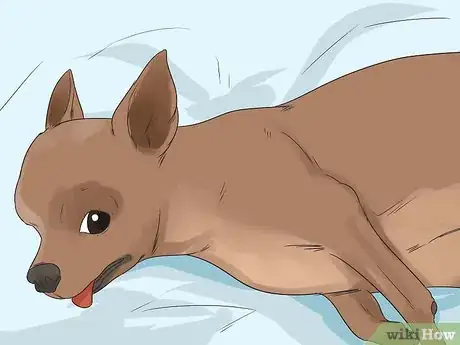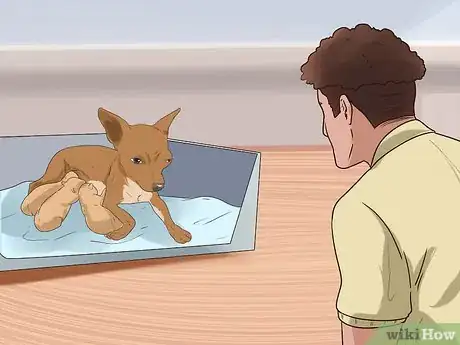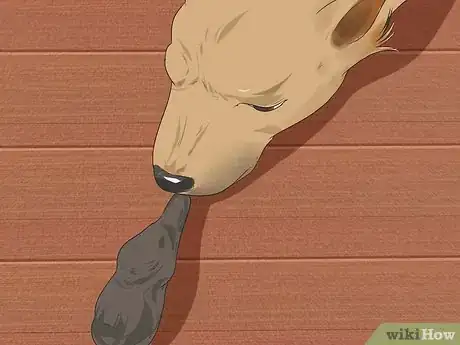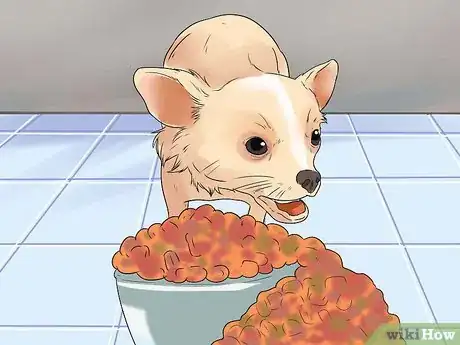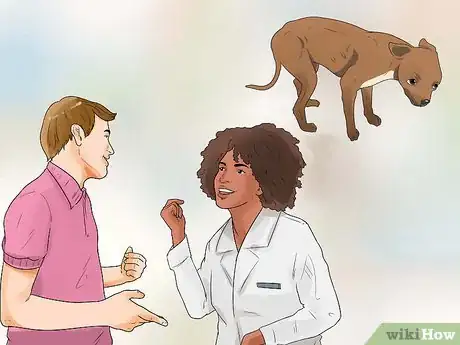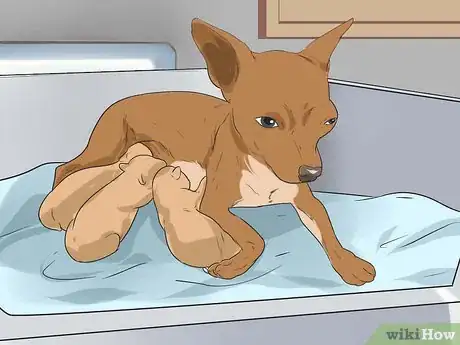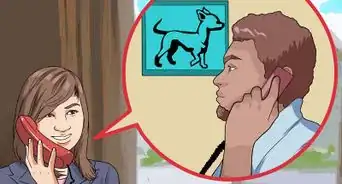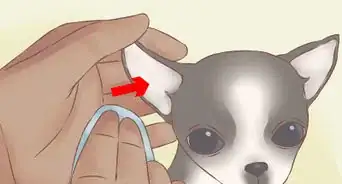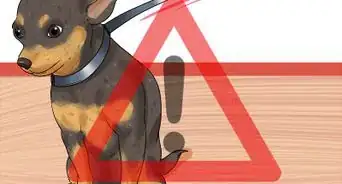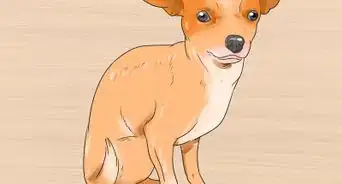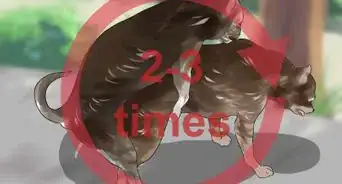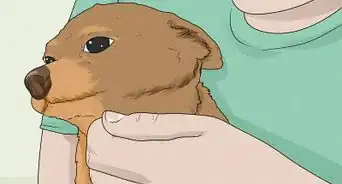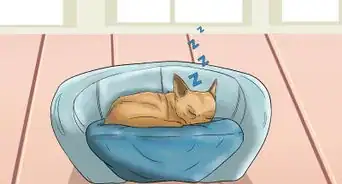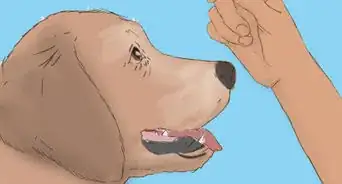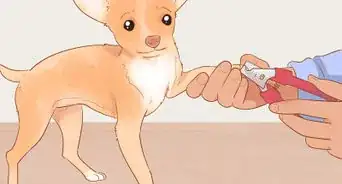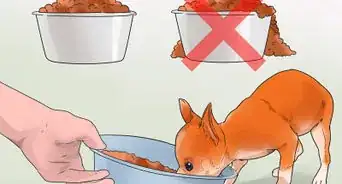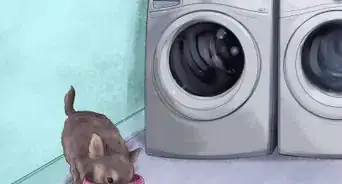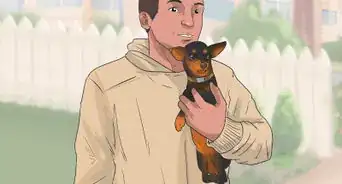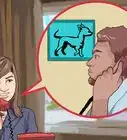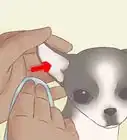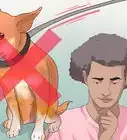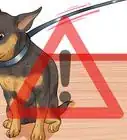This article was co-authored by Pippa Elliott, MRCVS. Dr. Elliott, BVMS, MRCVS is a veterinarian with over 30 years of experience in veterinary surgery and companion animal practice. She graduated from the University of Glasgow in 1987 with a degree in veterinary medicine and surgery. She has worked at the same animal clinic in her hometown for over 20 years.
wikiHow marks an article as reader-approved once it receives enough positive feedback. This article received 19 testimonials and 100% of readers who voted found it helpful, earning it our reader-approved status.
This article has been viewed 247,534 times.
Chihuahuas are small dogs, so their labor and delivery process can involve some complications. Chihuahua puppies have disproportionately large heads, which leads to an increased chance of them getting stuck in their mothers' birth canal. For this reason and to avoid additional stress or endangerment of your chihuahua and her puppies, make sure you are prepared for the birth. Further, knowing the signs of trouble can help you get your chihuahua through labor and delivery safely.
Steps
Preparing for Labor
-
1Understand the normal progression of pregnancy in chihuahuas. The average gestation period for a dog is between 58 and 68 days. Try to pinpoint when conception occurred so you can anticipate your dog's labor accordingly. Chihuahuas tend to deliver at 8 weeks gestation.[1]
-
2Take your dog to the veterinarian. If you are deliberately trying to breed your dog, take her to the veterinarian for a check-up beforehand. Re-visit the vet again about 30 days into the pregnancy.[2] If the pregnancy wasn’t planned, however, take her to the vet as soon as you discover she’s pregnant.
- The vet can give you critical information that will help you ensure your dog has a healthy pregnancy. One important thing to discuss is proper nutrition. Pregnant dogs that are overweight are more likely to have difficulties giving birth. However, pregnancy is not an ideal time to put chihuahuas on a diet, since the mother actually needs more calories in order to pass nutrients onto her litter. One recommendation is to delay putting your dog onto energy-dense, high-caloric foods (such as puppy food) until the final 2-3 weeks of pregnancy. At this point your dog will have a large womb and only want to snack anyway.[3]
- Your vet can also count the number of puppies in the litter using x-rays. This happens at 45 days of pregnancy. Three to four puppies is normal for a typical chihuahua litter. Knowing how many puppies your dog is expecting can help you better prepare for the birth. If a very large or small number of puppies is expected, your dog may experience complications during labor. Your vet can recommend whether to pursue natural labor or a planned C-section. Further, knowing the number of puppies will also help you be certain when she is finished whelping (or giving birth). For example, if your dog is carrying four puppies, gives birth to three puppies, and then stops laboring, you will be able to identify that something is wrong and contact your vet.[4]
Advertisement -
3Buy puppy formula ahead of time. If a puppy has trouble nursing, you'll want to have formula on hand since newborn puppies need to be fed every 2-4 hours.
- You can buy puppy formula and bottles at most pet supply stores. If you cannot find puppy formula, you can also use goat's milk, although this is not ideal for long-term use. Goat's milk should only be used in emergencies until you can buy some formula.
Easing Your Chihuahua into Labor
-
1Isolate the mother from other dogs 3 weeks before delivery. To protect the mother and her puppies from contracting illnesses or diseases like canine herpes, keep her away from all other dogs in the 3 weeks leading up to her expected delivery date.[5]
- It’s also highly advisable to keep the mother away from other dogs for three weeks following the delivery.[6]
-
2Prepare a nesting area. About a week before your dog is due to begin labor, set up a whelping box in a quiet, private area. A whelping box (also commonly known as a nesting box or whelping pen) protects puppies during birth and early life by keeping them safely contained and protected.[7]
- A whelping box can be as simple as a cardboard box. You can also purchase whelping boxes or build one yourself. There are many plans available online than range from simple boxes to more elaborate designs that can accommodate growing puppies.
- Desirable features of a whelping box include ease of cleaning and sanitation, extensibility, and durability. Depending on your particular situation, you may also want the whelping box to be portable.
- Make sure the sides of the box are easy for the mother to get in and out of, but sturdy enough that the newborn puppies cannot get out of the box.
- For a quick alternative, a kiddy pool with bedding like clean old towels or blankets can act as an effective whelping box.
- Set up the whelping box in a calm and quiet area away from other pets and household activities. Make this a cozy and warm space where she can go to give birth safely.
-
3Observe your chihuahua's behavior. You may notice that as your dog gets closer to full term, she exhibits nesting behavior and a tendency to withdraw or retreat. This is normal and is to be expected during the last few weeks of pregnancy. However, the opposite is also true; it's also normal for a pregnant dog to be clingy and want attention!
-
4Watch for signs of imminent labor. There will be several signs to help you anticipate when labor is imminent; watch for them carefully so you can be prepared when it is time.
- When your dog is close to giving birth, her teats will enlarge as her milk comes in. This can happen within a few days or as labor begins, so watch closely.
- The vulva will get larger and more relaxed a few days before labor.
- Most dogs will stop eating as labor begins. Vomiting and/or becoming 'picky' is also common.
-
5Take your dog’s temperature. The dog’s temperature will drop a degree or so about 24 hours before labor. Get an idea of her normal temperature by measuring it every morning for the last week or two of pregnancy.
- Lubricate a rectal thermometer and insert it about half an inch for three minutes to take your dog’s temperature. Her normal temperature will likely range between 101 and 102.5 degrees Fahrenheit.
- When you notice a decrease of a degree or more, it’s a sign she will likely begin labor in 24 hours or less.[8]
-
6Identify the first stage of labor. This is when your dog's body prepares to give birth. Hormones are given off which relax the exit from the womb (the cervix). This is so that when true contractions start, the puppies can be expelled. These hormones also prime the muscles of the uterus with practice contractions. This practice phase helps prepare your dog for the more sustained contractions of the second stage of labor. [9]
- Generally this first stage of labor lasts 24 hours. There is no immediate cause for concern if your dog starts acting oddly and nothing happens for a whole day.[10]
- You may not be able to recognize that your dog is in the first stage of labor. She may withdraw or show signs of nesting, but these behaviors can also occur prior to the onset of labor.
Helping During Labor
-
1Let your dog take the lead. Your chihuahua may pant, whimper, move around as though uncomfortable, or hide. She may want to be with you or she may wish to be alone. [11]
- Keep the lighting dim and the atmosphere relaxed and private.
- The safer and less stressed the mother feels, the better she will be equipped to respond to the needs of her puppies.
-
2Offer your chihuahua water. Once your dog is in active labor, she should not eat (nor will she likely want to). You should, however, be sure to offer water, though she may not want to drink it.
-
3Watch for contractions. When she has a contraction, it will be easy to identify–it will appear as a sort of wave across her belly. If you lay your hand on her belly, you will feel the uterus contract and tighten.
- As she gets closer to delivering a puppy, you will notice her contractions become more frequent and/or pronounced. She may stand up, which is fine; don’t try to force her to lie down.
-
4Prepare for the second stage of labor. This is the active "pushing" phase of labor, where your dog pushes the puppies out. This is characterized by the dog lying on her side and pushing with visible effort. You will likely see her holding her breath and the muscles of her flanks rippling and pressing down. She may grunt or groan as she presses, and generally give the impression that she is exerting herself.
- It takes on average 30 minutes of hard labor for each puppy to be born. However, this varies greatly; some puppies are born just minutes apart, while others are born with an hour in between.[12]
-
5Watch for any warning signs or complications. The most likely complication is that a puppy will get stuck in the birth canal. Because a chihuahua's head is large, it can be physically too big to pass. If you see paws appear at the vulval lips and notice that the dog continues to strain but that after 60 minutes no puppy is passed, you should contact your vet. Do not pull on the paws as you could cause internal tearing. In general, you should contact your vet if:[13]
- The dog does not start hard labor after 24 hours in the first stage of labor.
- No puppy is produced after 60 minutes of hard straining.
- The dog appears to be in extreme or abnormal pain.
- Not all of the puppies have been born, but the dog has not pushed for 2 hours.
- Keep in mind that some dogs rest between individual deliveries. A dog can relax for up to 2 hours before the next bout of hard labor.
- However, if you know how many puppies she is carrying, and they have not all been delivered but her hard contractions stopped more than 2 hours ago, you should be concerned.
-
6Observe the mother and pup closely after each one is delivered. The puppies may be born either tail or head first; both are normal.[14] When the mother delivers, each pup will be in its own amniotic sac; the mother should tear it open, then chew off the umbilical cord, and lick the pup. It's usually best to let her do this without human assistance because it is part of her bonding with the puppies. Don't be afraid to give the mother a few minutes to get the hang of things.[15]
- If she doesn’t tear open the sac within a maximum of two minutes, you should gently open it with a clean hand. Remove the slippery covering and rub the puppy with a clean towel. Tie the umbilical cord in a knot about one inch from the pup and cut with scissors on the far side of the knot.[16]
- If the pup is unresponsive, clear all fluid away from the pup’s nose and mouth. Rub the pup vigorously but with gentle pressure to stimulate breathing. Encourage the mother to lick her baby. You may need to put the pup in front of her several times, particularly if this is her first litter.
-
7Allow your dog to go through the third stage of labor. This is the passing of the "afterbirths", or placentas. Usually this occurs after each pup. Try to check how many placentas have been passed, so you that will notice if any are left in the uterus. If this is the case, contact your vet.[17]
- Your dog will likely eat the placentas; do not interfere with her ability to do so, as this is a normal biological process.
Caring for Your Chihuahuas After Delivery
-
1Feed the dogs well. It’s important for both mother and puppies to receive enough nutrition so that the mother can recover and the puppies can develop healthily.
- Most dogs will eat the placenta and afterbirth. This is very nutrient-rich and gives the mother a much-needed burst of energy to care for her young.
- Feed your nursing mother puppy food. Be prepared to feed her up to 3 times her normal intake of food. Clean, fresh water must be available at all times. Place these near her puppies so that she will not need to leave them to eat and drink. Insufficient food or water will trigger the mother's milk to dry up.
-
2Monitor the mother in the weeks following birth. Expect things to go well but be prepared for complications. Because chihuahuas are a small breed, infections can quickly become life-threatening. Consult your vet if you suspect your dog has any of the following:[18]
- Metritus (an inflamed uterus) - Symptoms include fever, foul-smelling discharge, listlessness, loss of appetite, decreased milk production, and disinterest in the puppies.[19]
- Eclampsia (or 'milk fever') - Symptoms include nervousness, restlessness, disinterest in the puppies, and a stiff, pained gait. If left untreated, eclampsia can progress into muscle spasms, inability to stand, fever, seizures, and death. This condition usually develops about 2-4 weeks after delivery.[20]
- Mastitis (inflammation of the breasts) - Symptoms include red, hardened, or painful mammary glands. The mother may try to discourage the puppies from nursing, but you want them to continue doing so, as it can help flush out the infection (without causing the puppies any harm).[21]
-
3Observe the mother and pups. The general rule of thumb after the mother has given birth is to watch out that she doesn’t stop caring for the pups or show signs of feeling ill.[22]
- A healthy mother will be alert and attentive to her newborns. She will only leave them for bathroom breaks and will want to rush back to them quickly. Her time should be spent licking them and feeding them.[23]
- She may or may not eat, but she should relive herself normally and drink water. She will still be bleeding but should not be in pain.
Expert Q&A
Did you know you can get expert answers for this article?
Unlock expert answers by supporting wikiHow
-
QuestionHow do I know if my dog is going into labor?
 Pippa Elliott, MRCVSDr. Elliott, BVMS, MRCVS is a veterinarian with over 30 years of experience in veterinary surgery and companion animal practice. She graduated from the University of Glasgow in 1987 with a degree in veterinary medicine and surgery. She has worked at the same animal clinic in her hometown for over 20 years.
Pippa Elliott, MRCVSDr. Elliott, BVMS, MRCVS is a veterinarian with over 30 years of experience in veterinary surgery and companion animal practice. She graduated from the University of Glasgow in 1987 with a degree in veterinary medicine and surgery. She has worked at the same animal clinic in her hometown for over 20 years.
Veterinarian
-
QuestionCan on checking her cause her to stop labor?
 Pippa Elliott, MRCVSDr. Elliott, BVMS, MRCVS is a veterinarian with over 30 years of experience in veterinary surgery and companion animal practice. She graduated from the University of Glasgow in 1987 with a degree in veterinary medicine and surgery. She has worked at the same animal clinic in her hometown for over 20 years.
Pippa Elliott, MRCVSDr. Elliott, BVMS, MRCVS is a veterinarian with over 30 years of experience in veterinary surgery and companion animal practice. She graduated from the University of Glasgow in 1987 with a degree in veterinary medicine and surgery. She has worked at the same animal clinic in her hometown for over 20 years.
Veterinarian
Warnings
- Do not supplement your pregnant chihuahua's diet with extra calcium unless instructed to do so by your veterinarian. Milk fever, or eclampsia, is common in small breeds a few weeks after giving birth and is more likely to occur with supplementation of calcium during pregnancy. Your dog will get everything she needs from the higher calcium content in puppy food.[24]⧼thumbs_response⧽
References
- ↑ http://www.veterinarypartner.com/Content.plx?P=A&A=678&S=0&EVetID=0
- ↑ http://www.veterinarypartner.com/Content.plx?A=1459
- ↑ http://www.veterinarypartner.com/Content.plx?P=A&A=678&S=0&EVetID=0
- ↑ http://www.veterinarypartner.com/Content.plx?A=1459
- ↑ http://www.veterinarypartner.com/Content.plx?P=A&S=0&C=0&A=1459
- ↑ http://www.veterinarypartner.com/Content.plx?A=1459
- ↑ http://www.purina.co.uk/content/your-dog/life-changes/pregnancy-in-dogs/labour-and-giving-birth-for-dogs
- ↑ http://www.veterinarypartner.com/Content.plx?P=A&A=678&S=0&EVetID=0
- ↑ Reproduction in the Dog and Cat. Christiansen. Publisher: Bailliere-Tindal.
- ↑ Reproduction in the Dog and Cat. Christiansen. Publisher: Bailliere-Tindal.
- ↑ http://www.purina.co.uk/content/your-dog/life-changes/pregnancy-in-dogs/labour-and-giving-birth-for-dogs
- ↑ Reproduction in the Dog and Cat. Christiansen. Publisher: Bailliere-Tindal.
- ↑ Reproduction in the Dog and Cat. Christiansen. Publisher: Bailliere-Tindal.
- ↑ http://www.purina.co.uk/content/your-dog/life-changes/pregnancy-in-dogs/labour-and-giving-birth-for-dogs
- ↑ http://www.veterinarypartner.com/Content.plx?P=A&A=678&S=0&EVetID=0
- ↑ http://www.veterinarypartner.com/Content.plx?P=A&A=678&S=0&EVetID=0
- ↑ http://www.purina.co.uk/content/your-dog/life-changes/pregnancy-in-dogs/labour-and-giving-birth-for-dogs
- ↑ http://www.veterinarypartner.com/Content.plx?P=A&A=678&S=0&EVetID=0
- ↑ http://www.veterinarypartner.com/Content.plx?P=A&A=678&S=0&EVetID=0
- ↑ Reproduction in the Dog and Cat. Christiansen. Publisher: Bailliere-Tindal.
- ↑ http://www.veterinarypartner.com/Content.plx?P=A&A=678&S=0&EVetID=0
- ↑ http://www.veterinarypartner.com/Content.plx?P=A&A=678&S=0&EVetID=0
- ↑ http://www.purina.co.uk/content/your-dog/life-changes/pregnancy-in-dogs/labour-and-giving-birth-for-dogs
- ↑ http://www.veterinarypartner.com/Content.plx?A=1459
- ↑ http://www.purina.co.uk/content/your-dog/life-changes/pregnancy-in-dogs/labour-and-giving-birth-for-dogs
- ↑ http://www.purina.co.uk/content/your-dog/life-changes/pregnancy-in-dogs/labour-and-giving-birth-for-dogs
About This Article
Since chihuahuas are such small dogs, they’re more likely to have complications during labor and may require help. Before your chihuahua goes into labor, take it the vet to make sure it has a healthy pregnancy, which can help prevent complications during labor. When your chihuahua goes into labor, she’ll likely want to withdraw and may have a slightly lower temperature. She may whine, pant, or move around. These are all normal. Just keep the lighting dim so she can relax and put out fresh water for her to drink. She’ll start to have contractions when the labor is getting closer. When she lies down and starts doing a “pushing” motion, she is ready to give birth. It usually takes roughly 30 minutes of labor for each puppy to be born, and the puppies may be born either head or tail first. If a puppy has not come out after 60 minutes of straining, or if your chihuahua seems to be in extreme pain, call your vet right away for help. As the puppies come out, watch for complications. If a puppy is unresponsive, clear fluid away from its nose and mouth, then rub the puppy vigorously with gentle pressure to stimulate breathing. After each puppy comes out, a placenta should pass with it. If not all the placentas come out, contact your vet. To learn how to care for your Chihuahua after giving birth, read on!
